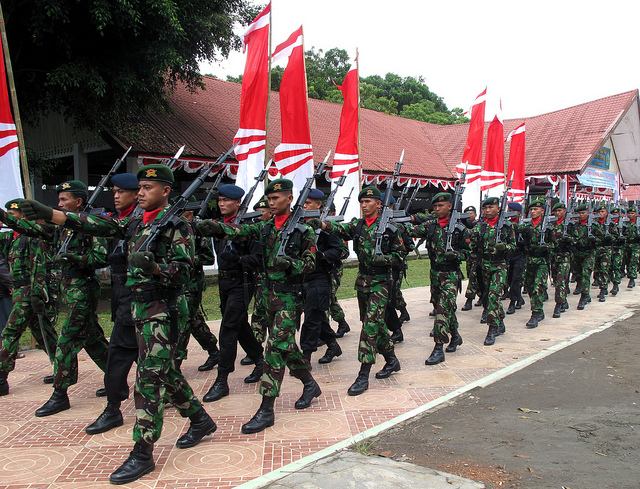
Indonesia’s latest Defence White Paper was issued in November last year and was publically released on 31 May. It supersedes the 2008 White Paper. Although a replacement paper was produced in the dying days of the Susilo Bambang Yudhoyono presidency, ultimately, it wasn’t adopted by the Jokowi government.
White papers can be an integral part of the defence planning process or they can be little more than public relations and propaganda. The latest Indonesian paper is a cosmetic addition to a defence planning process that’s independent of the White Paper and remains largely opaque. The Paper describes the planning process but gives few clues about how Indonesia links threat assessments with defence policy, doctrine, strategy and resource constraints to produce the most effective and efficient force it can afford.
That’s driven by a concern for security and by the fact that it isn’t just a defence white paper—it’s also a national security paper outlining the responsibilities of all arms of government for defence and security more generally.
Nevertheless, if you’re looking for confirmation of Indonesia’s foreign and defence policy, its threat assessments, its international partnerships and its general priorities for the future, you’ll gain some comfort from this 130-page process—rather than outcome—oriented document.
Threat perceptions remain holistic here and elsewhere, covering the spectrum from juvenile delinquency and the LBGT community to terrorism and WWIII. Threats are classified as military, non-military or hybrid and further subdivided into known and not yet known threats with priority given to the former.
A serious external threat is deemed by Indonesia to be unlikely and the known threats are primarily domestic including terrorism and radicalism, separatism, revolt, natural disasters, border violations, piracy, theft of natural resources, pandemics, cyber warfare, espionage, and narcotics. Most of those are the first priority of other arms or agencies of government and provide little guidance for determining force structures or dispositions.
There’s been no fundamental change in Indonesia’s defence policy. It adheres to the historic non-aligned no alliances policy and its continuing support for the United Nations. Indonesia’s neighbours are reassured that it has no aggressive intent and seeks peaceful solutions to outstanding problems related to the definition of borders and other cross border tensions. The White Paper lists the contestants in the South China Sea conflict—not including Indonesia—and calls for a peaceful solution while simultaneously nominating the development of its bases in the Natuna Islands as a priority.
The White Paper advocates global partnerships to create the ‘dynamic equilibrium’ promoted by SBY to form the conditions in which no one nation dominates the region. In the absence of alliances, this is to be achieved though the development of partnerships embracing all the major regional players. That’s illustrated by the classification of both China and the US as strategic partners followed by the lesser lights. But just to be safe, Indonesia’s maritime forces will be strengthened to secure Jokowi’s Global Maritime Axis that would see Indonesia become a major production and shipping hub on the maritime cross roads of the Indian and Pacific oceans.
Indonesia can’t compete with other major regional powers so the White Paper retains a total people’s war policy and strategy that would see the whole human and material resources of the nation mobilised to deal with internal and external threats. That in turn normalises its concern and involvement in policy matters outside the remit of defence in a democracy.
Future plans seek qualitative improvements in defence capability without any addition to its current force of about 435,000 uniformed personnel. That will be based on three defence areas covering the three major maritime approaches to Indonesia from the north, including joint command and control of allotted forces and the army’s territorial commands. The army’s territorial commands remain the last ditch of defence and its political and internal security infrastructure. Defence industry will also be boosted to include funding the building of more ships, submarines, aircraft, and armoured vehicles, and the production of consumables.
The Paper is deeply concerned with creating the responsible citizen, a concern stemming from the fear of terrorism and radicalism that might gain enough support to cause internal strife that would undermine the economy or even overturn the historic compromises enshrined in the preamble to the constitution, commonly known as the Pancasila. Consequently, the Paper outlines the program begun last year to indoctrinate 100 million citizens over the next ten years as well as incorporating it in educational curricula and professional training courses.
In a dig at the last government, leading its agenda of defence priorities is the Paper’s declared support for the government’s election pledge to reassert the responsibility of the state in protecting all citizens; creating clean, effective, and respected democratic government; and creating a strong state through the reform of the justice sector.
The inclusion of such matters in the Paper is a reminder that security sector reform, as distinct from military reform, stopped in Indonesia in 2004 and hasn’t progressed much since because the executive and parliament lack the confidence to carry it to completion and/or find that having the TNI on tap remains politically expedient and convenient. It demonstrates a lack of confidence in the people and the competence and capacity of the relevant institutions and agencies, especially in the justice sector, to perform their functions effectively. Some of those concerns are justified and need serious attention but they’re also self-serving.
Like white papers around the world, it laments that the government hasn’t lived up to its past spending commitments. It seeks defence spending of 1% of GDP now, with undefined increases over the next ten years, to achieve the ‘minimum effective force’. The paper doesn’t discuss what ‘minimum’ or ‘effective’ means. The only specific capabilities mentioned are the use of satellites and drones to support maritime security.
The Paper does little to convince Indonesians of the purpose and composition of their future defence forces or to justify the money that has to be spent on them. However, it does reassure neighbouring countries of Indonesia’s benign intent.

